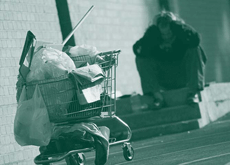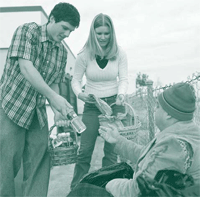July/August 2008
In this Issue
Toward Understanding Homelessness
Homelessness: A National Perspective
Calculating the True Cost of Housing
A Focus on Fair Housing
In the next issue of ResearchWorks
Toward Understanding Homelessness
A recent HUD report found that about 1.6 million Americans had slept in a homeless shelter or transitional housing sometime over a 12-month period beginning in October 2006. In March 2007, the U.S. Department of Health and Human Services and HUD jointly sponsored a national symposium to review progress in homelessness research and practice over the past decade.
Since 1998, when a similar symposium occurred, a significant amount of research has accrued on homelessness, its causes, and interventions that may reduce its incidence. National priorities have emerged that focus on the subpopulation of the chronically homeless and on permanent housing responses to the problems of homelessness. The development and refinement of information systems make increased cooperation and coordination of homeless response possible at the local level, while bringing the size and nature of the national problem into sharp focus. Seemingly new variations on homelessness have emerged, such as those relating to departures from the criminal justice system.

The research reveals two significant developments in the struggle to end homelessness. An increased emphasis on data collection in the past decade, particularly with Homeless Management Information Systems and other administrative data tools, has allowed practitioners and researchers to determine how many homeless people are being served throughout the country, their characteristics, and the length and pattern of their stays in shelters and transitional shelters. Another important advance has been the advent of collaborative efforts to address homelessness at all levels, including local and state 10-year plans to end homelessness, Continuum of Care programs, and the expansion of services.
The papers presented at the national symposium are published in Toward Understanding Homelessness: The 2007 National Symposium on Homelessness Research. Presenters examined the historical response to homelessness, employment and income supports for the homeless, program accountability and cost-effectiveness, housing models that have emerged over the past decade, and how the needs of particular homeless subpopulations are being addressed. Homeless groups with unique needs that drew research attention included people who are chronically homeless, families with children, youth, the rural homeless population, and ex-offenders. A sampling of the research presented at the symposium follows.
People Who Experience Long-Term Homelessness: Characteristics and Interventions
This paper examines the chronically homeless population and looks at programs that work with this relatively small subpopulation that, in many jurisdictions, consumes a disproportionately large share of shelter, emergency room, and inpatient hospital services. A chronically homeless person is defined as
... [a]n unaccompanied individual with a disabling condition who has been continuously homeless for a year or more or has experienced four or more episodes of homelessness over the past 3 years. A disabling condition is defined as a diagnosable substance abuse disorder, serious mental illness, developmental disability, or chronic physical illness or disability, including the co-occurrence of two or more of these conditions.1
The authors look at successful housing and supportive services models that help the chronically homeless find permanent housing, manage their disabilities, and obtain employment.
Homeless Families and Children
Homeless families with children are more likely than homeless individuals to be members of a minority group (although race/ethnicity varies geographically), have very-low incomes, and have preschool-age children. These families tend to have low educational levels; minimal work histories; and health, substance abuse, or mental health issues. The authors examine the impact of shelter stays on children's physical and mental health, education, and overall development.
Rural Homelessness
This study looks at the special challenges surrounding rural homelessness, while acknowledging the difficulty of obtaining an accurate count of the rural homeless population given existing counting methodologies. Among other factors, high rental costs and lower incomes create a housing/income gap, and the relatively low fair market rents in most rural areas tend to discourage development of new affordable housing. The rural homeless population tends to be younger than its urban counterpart, have more health problems but less access to healthcare, have higher employment rates than those in urban areas but tends to be underemployed, and lacks mental health and other services (although there is often a stigma attached to the use of such services when available).
Incarceration and Homelessness

According to the authors of this paper, people leaving the criminal justice system face an increased risk of homelessness and those already homeless are at increased risk of incarceration. Those being released from prison or jail face a number of reentry issues, including a lack of discharge planning and transition services, difficulty in obtaining employment, the absence of effective support networks, and numerous barriers to housing. Ex-offenders are banned from much subsidized housing, and unsubsidized housing is frequently too expensive. The authors note that supportive housing with services may be the most cost-effective way to house ex-offenders.
Housing Models
This paper examines the three general categories of housing available to America’s homeless population: emergency shelter, transitional housing, and permanent supportive housing. These housing models have different physical configurations, expected lengths of stay, and degrees of flexibility in resident choice. Over the past decade, however, two different permanent supportive housing programs have emerged as mainstream models for the homeless.
Housing First programs, including safe havens, offer permanent affordable housing with multiple services to help residents deal with substance abuse, mental health, and other issues. Participation in these services is optional and does not affect accessibility to the housing. Housing-readiness programs take a much more restrictive approach, with high thresholds for admission that many chronically homeless individuals may initially find difficult to meet. These conditions can include sobriety, basic living skills, good personal hygiene, and mandatory participation in treatment programs.
Toward Understanding Homelessness: The 2007 National Symposium on Homelessness Research, which includes recommendations for future study and programs, can be downloaded at no charge from the HUD USER website at www.huduser.gov/publications/homeless/homeless_symp_07.html. Information is also given there for obtaining printed copies of the report.
1. U.S. Department of Housing and Urban Development, U.S. Department of Health and Human Services, and Department of Veterans Affairs. Notice of funding availability (NOFA) for the collaborative initiative to help end chronic homelessness. 68 Federal Register 4017 (January 27, 2003).

